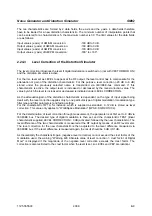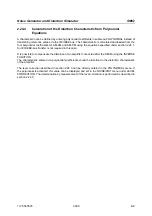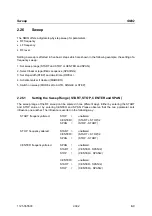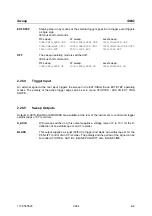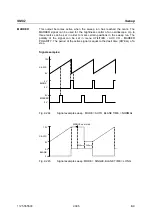
LIST Mode
SMIQ
1125.5555.03
2.402
E-9
STEP
Step-by-step manual processing of the list. Activating STEP stops a list running and
the cursor wraps to the indication value of CURRENT INDEX. The list can now be
controlled upwards or downwards in discrete steps using the rotary knob or the
numeric keys.
IEC/IEEE-bus commands:
:SOUR:FREQ:MODE LIST
:SOUR:LIST:MODE STEP
:TRIG:LIST:SOUR SING
EXT-SINGLE
Single run from the beginning to the end of the list as with SINGLE, but triggered by
an external trigger signal.
IEC/IEEE-bus commands:
:SOUR:FREQ:MODE LIST;
:SOUR:LIST:MODE AUTO
:TRIG:LIST:SOUR EXT
EXT-STEP
Step-by-step run by means of the external trigger signal. Each trigger event triggers
a single step.
IEC/IEEE-bus commands:
:SOUR:FREQ:MODE LIST
:SOUR:LIST:MODE STEP
:TRIG:LIST:SOUR EXT
HOP
Step-by-step run by means of the internal trigger signal of the data generator (see
also Section 'Internal Modulation Data and Control Signals from Lists' and Section
'Menu DIGITAL STANDARD - GSM'). Each trigger event triggers a single step.
IEC/IEEE-bus commands:
:SOUR:FREQ:MODE LIST
:SOUR:LIST:MODE STEP
:TRIG:LIST:SOUR HOP
OFF
Operating mode LIST is switched off.
IEC/IEEE-bus command:
:SOUR:FREQ:MODE CW
Note:
The minimum step time of 1 ms must not be violated in modes EXT-STEP and HOP either.
With fading switched on, the minimum step time is increased to 3 ms, in case of Lognormal
fading it is increased to 50 ms.
2.27.2 Inputs/Outputs
TRIGGER input and BLANK output are available at the rear of the instrument for synchronization with
other instruments.
TRIGGER
An external signal at this input triggers the LIST mode in operating modes
EXT-SINGLE and EXT-STEP. The polarity of the active trigger edge can be
set in the UTILITIES - AUX I/O - EXT TRIG SLOPE menu.
BLANK
This output supplies a signal (0 V/5 V) to blank the settling process by means
of pulse modulation or AM. The signal can also be used to synchronize other
instruments. The polarity of the signal can be set in the UTILITIES - AUX I/O -
BLANK POLARITY menu.

